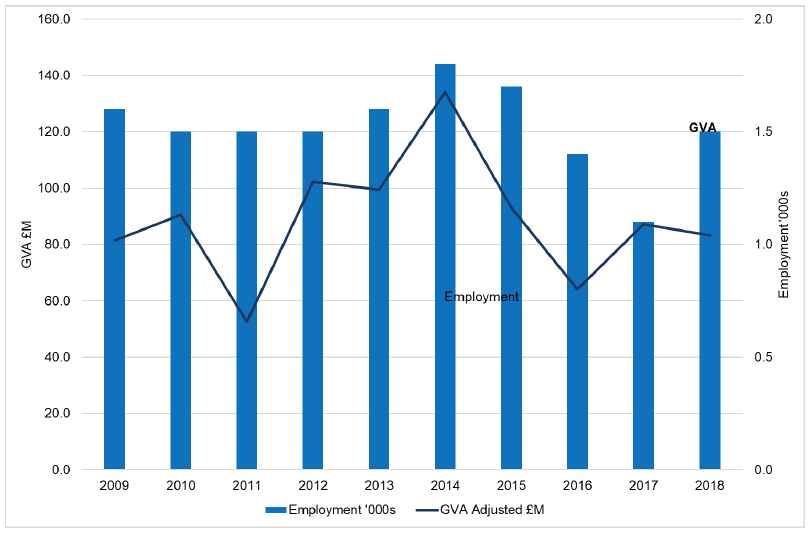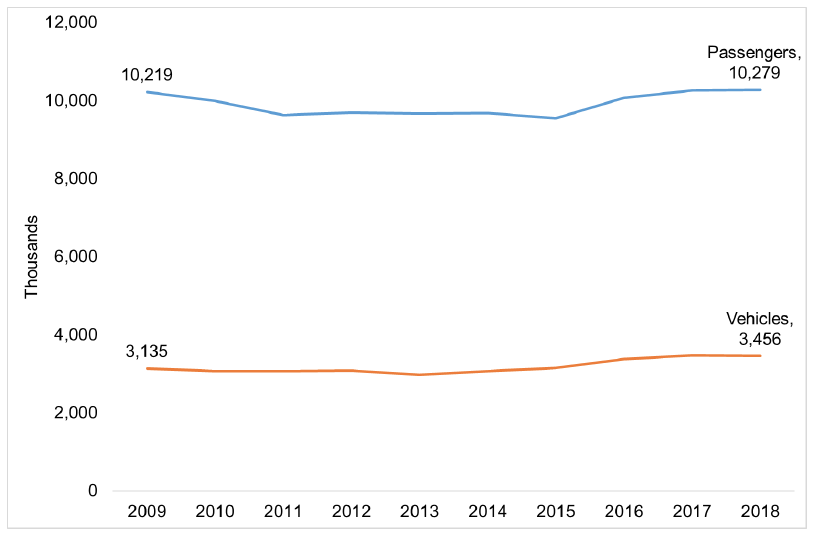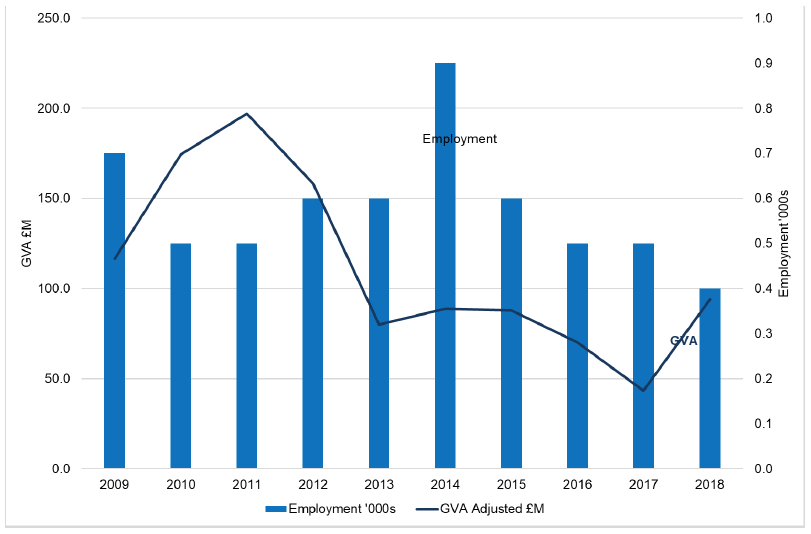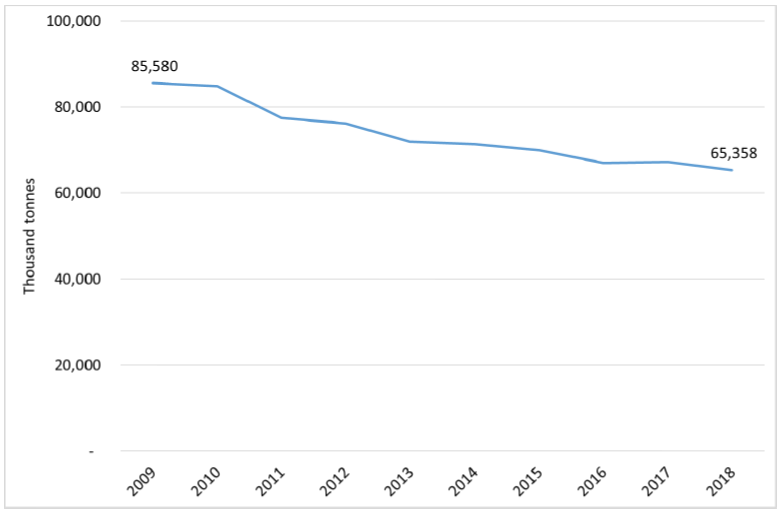Scotland's marine economic statistics 2018
Statistics on the economic contributions of Scotland’s marine sectors in 2018. Includes a time series of Gross Value Added (GVA), turnover and employment for industrial categories defined as part of the marine sector.
This document is part of a collection
9. Sea & coastal water transport
9.1 Introduction
This sector includes passenger and freight transport, though they are discussed separately. Inland water transport is not included. Sea and coastal water transport is an essential part of Scotland's transport network. It is key for connectivity and supports both island and mainland communities. One third of Scotland's total freight tonnage, including exports, was carried by water transport in 2018 [8].Supplementary water transport information is taken from the Transport Scotland Scottish Transport Statistics publication, supported by data from the Department of Transport statistics.
9.2 Passenger water transport – description
Sea and coastal passenger water transport includes the transport of passengers on vessels designed for operating on sea or coastal waters.
It includes:
- transport of passengers over seas and coastal waters, whether scheduled or not,
- operation of excursion, cruise or sightseeing boats,
- operation of ferries, water taxis etc.,
- renting of pleasure boats with crew for sea and coastal water transport (e.g. for fishing cruises).
This class excludes:
- restaurant and bar activities on board ships, when provided by separate units,
- renting of pleasure boats and yachts without crew,
- renting of commercial ships or boats without crew,
- operation of "floating casinos".
The sea and coastal water transport categories are not included in the Marine tourism sector so the values are not double counted.
9.3 Passenger water transport – economic key points
In 2018, passenger water transport generated £83 million in GVA: accounting for 0.06% of the overall Scottish economy and 2% of the marine economy GVA. The passenger water transport industry provided employment for 1,500 people (headcount), contributing 0.06% of the total Scottish employment and 2% of the marine economy employment.
9.4 Passenger water transport – trends
From 2017 to 2018, the GVA from passenger water transport (adjusted to 2018 prices) decreased by 5%, while the longer term trend from 2009 to 2018 showed that passenger water transport GVA fluctuates from year to year, but rose by 2%. Employment in 2018 rose by 36% to 1,500, following the ten year low in 2017. From 2009 to 2018, employment fell by 6%.
| Year | GVA | Turnover | Employment | GVA Per Head |
|---|---|---|---|---|
| £M | £M | '000s | £ | |
| 2009 | 81 | 391 | 1.6 | 50,823 |
| 2010 | 91 | 271 | 1.5 | 60,374 |
| 2011 | 52 | 399 | 1.5 | 34,959 |
| 2012 | 102 | 343 | 1.5 | 68,185 |
| 2013 | 99 | 382 | 1.6 | 62,123 |
| 2014 | 134 | 353 | 1.8 | 74,482 |
| 2015 | 93 | 232 | 1.7 | 54,772 |
| 2016 | 64 | 179 | 1.4 | 45,790 |
| 2017 | 87 | 203 | 1.1 | 79,295 |
| 2018 | 83 | 305 | 1.5 | 55,467 |

Transport Scotland statistics (Figure 14) show that the number of passengers in 2018 has increased by less than 1% from 2009, while the number of vehicles increased by 10%.

Source: Transport Scotland from ferry operators (not National Statistics)[9]
9.5 Passenger water transport – by geography
Transport Scotland report these services by operator rather than location, meaning that these statistics show a broad distribution of ferry business rather than a precise disaggregation. In 2018, around 51% of the passenger journeys were on the Caledonian MacBrayne services in the West of Scotland, between the mainland of Scotland and 22 of the major islands on Scotland's west coast. The next highest service was between Gourock and Dunoon, also on the West coast and carried 13% of passenger traffic, Shetland Island services carried 7% of passengers. The rest of the passengers carried in 2018 travelled on other services. The vehicle transport distribution is similar to passenger transport, with 44% on the Caledonian MacBrayne services in the West of Scotland, 19% between Gourock to Dunoon and 11% on Shetland Island services.
9.6 Freight water transport – description
This group includes the transport of freight on vessels designed for operating on sea or coastal waters. It includes:
- transport of freight over seas and coastal waters, whether scheduled or not,
- transport by towing or pushing of barges, oil rigs etc.,
- renting of vessels with crew for sea and coastal freight water transport.
It excludes:
- storage of freight,
- harbour operation and other auxiliary activities such as docking, pilotage, lighterage, vessel salvage,
- cargo handling,
- renting of commercial ships or boats without crew.
9.7 Freight water transport – economic key points
In 2018, freight water transport generated £94 million GVA: accounting for 0.07% of the overall Scottish economy and 2% of the marine economy GVA.
The freight water transport industry provided employment for around 400 people (headcount), contributing 0.02% of the total Scottish employment and 0.5% of the marine economy employment.
9.8 Freight water transport – trends
From 2017 to 2018, the GVA from freight water transport (adjusted to 2018 prices) increased by 117%, while the longer term trend from 2009 to 2018 showed that freight water transport GVA fell by 19%. GVA reached a peak of £197 million in 2011, and fell to a low of £43 million in 2017.
| Year | GVA | Turnover | Employment | GVA Per Head |
|---|---|---|---|---|
| £M | £M | '000s | £ | |
| 2009 | 116 | 383 | 0.7 | 166,238 |
| 2010 | 174 | 343 | 0.5 | 348,895 |
| 2011 | 197 | 398 | 0.5 | 394,242 |
| 2012 | 158 | 279 | 0.6 | 264,013 |
| 2013 | 80 | 383 | 0.6 | 133,182 |
| 2014 | 89 | 288 | 0.9 | 98,477 |
| 2015 | 88 | 252 | 0.6 | 146,331 |
| 2016 | 70 | 190 | 0.5 | 140,285 |
| 2017 | 43 | 119 | 0.5 | 86,816 |
| 2018 | 94 | 300 | 0.4 | 235,000 |
From 2009 to 2018, employment fell by 43%, from a high of 900 people in 2014 to 400 in 2018.

Figure 16 shows Transport Scotland's statistics for the tonnage of freight traffic through Scottish ports. There were 65 million tonnes of freight handled by ports in Scotland in 2018, a 3% reduction on 2017. However, between 2009 and 2018 the total tonnage of freight traffic through Scottish ports reduced by 24%.

Source: DfT Maritime and shipping statistics Table PORT0101.
9.9 Freight water transport – by geography
The highest freight traffic in 2018 was through Forth ports (43% of tonnage through the top 11 ports), Clyde ports (15%) and Glensanda (10%).
| Port | Tonnage | % of total tonnage through Scotland's top 11 ports | |
|---|---|---|---|
| Aberdeen | 4,138 | 7% | |
| Cairnryan | 2,857 | 5% | |
| Clyde | 9,087 | 15% | |
| Cromarty Firth | 275 | 0% | |
| Dundee | 608 | 1% | |
| Forth | 26,587 | 43% | |
| Glensanda | 5,943 | 10% | |
| Orkney | 3,470 | 6% | |
| Peterhead | 1,131 | 2% | |
| Stranraer / Loch Ryan | 2,546 | 4% | |
| Sullom Voe | 5,329 | 9% | |
| Total | 61,969 | 100% | |
Source: Transport Scotland, Scottish Transport Statistics No 38 2019 Edition.
Contact
Email: marineanalysis@gov.scot
There is a problem
Thanks for your feedback